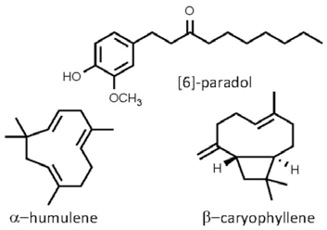 Aframomum melegueta
Aframomum melegueta
Melegueta pepper • grains of paradise
Back to “Spices: grains of paradise (Aframomum melegueta)s; Melegueta pepper (Aframomum melegueta)s”
Aframomum melegueta (Roscoe) K. Schum. (Zingiberaceae); malegueta-peper (Afrikaans); khayrbûâ (Arabic); paradijskorrels (Dutch); malaguette, maniguette, poivre de Guinée, graines de paradis (French); Malagettapfeffer, Meleguetapfeffer, Paradieskörner, Guineapfeffer (German); grani de melegueta, maniguetta (Italian); rajskiye zyorna, malagvet (Russian); malagueta (Spanish)
DESCRIPTION Small reddish-brown seeds of about 3 mm (⅛ in.) in diameter, resembling cardamom but with a distinctive warty surface. When crushed they have an aromatic smell and a sharp and pungent but spicy taste (once described as “dense fragrance underlined with heat”). The ground seeds have a greyish colour. The product is also known as grains of paradise and alligator pepper but sometimes called Guinea grains or Guinea pepper1 (see notes).
THE PLANT A leafy, clump-forming perennial herb, up to 1.4 m (ca. 5 ft) high, with attractive orange flowers and ovoid fruit capsules borne near the ground.
ORIGIN West coast of Africa, including Cameroon, Ghana (the main source of exports), Ivory Coast, Liberia, Nigeria and Togo. This area was once known as Melegueta or the “pepper coast”. The name is derived from the ancient empire of Melle or Meleguetta in the upper headwaters of the Guinea River, which was the original centre of commercial exploitation.1
CULTIVATION It is easily cultivated by planting the rhizomes in warm, humid and partially shaded places.
HARVESTING The ripe fruits (apparently edible) are dried to a pale grey colour and then tied in small bundles.
CULINARY USES This was a valuable substitute for pepper in the days before the oceanic spice route and is still important in West and North African cookery (e.g. as ingredient of spice powders, such as Moroccan ras el hanout and Tunisian five-spice mixture called gâlat dagga). This unique spice is making a comeback, not only as an ingredient of old recipes (to flavour beers, spiced wines and sausages) but as a (less pungent) substitute for pepper in stews and vegetable dishes. It should be ground and added in liberal amounts to the dish just before serving.
FLAVOUR COMPOUNDS The essential oil contains caryophyllene and humulene, with smaller amounts of their oxides, as well as α-cardinol. The pungent taste can be ascribed to (6)-paradol and other hydroxyarylalkanones.

NOTES Strictly speaking, “grains of paradise” refers to Aframomum granum-paradisi, while “Melegueta pepper” is the correct name for A. melegueta. Most authorities regard the former as a synonym of the latter. Another species, A. angustifolium, is known as great cardamom, Cameroon cardamom or Madagascar cardamom. Melegueta pepper is used in West Africa to freshen the breath, warm the body and to treat dyspepsia. Xylopia aethiopica (Guinea pepper) is another West African spice used in much the same way as pepper.3 The smoked and dried fruits have a peppery flavour ascribed mainly to the presence of linalool in the essential oil.4
1. Burkill, H.M. 2000. The useful plants of West Tropical Africa (2nd ed.), Vol. 5, pp. 312–314. Royal Botanic Gardens, Kew.
2. Fernandez, X., Pintaric, C., Lizzani-Cuvelier, L., Loiseau, A.-M., Morello, A., Pellerin, P. 2006. Chemical composition of absolute and supercritical carbon dioxide extract of Aframomum melegueta. Flavour and Fragrance Journal 21: 162–165.
3. Burkill, H.M., 1985. The useful plants of West Tropical Africa (2nd ed.), Vol. 1, pp. 130–132. Royal Botanic Gardens, Kew.
4. Tairu, A.O., Hofmann, T., Schieberle, P. 1999. Identification of the key aroma compounds in dried fruit of Xylopia aethiopica. In: Janick, J. (Ed.), Perspectives on new crops and new uses, pp. 474–478. ASHS Press, Alexandria.